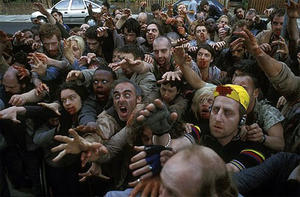Zombie apocalypseFirst responders drill response to a “Night of the Walking Dead” scenario
DHS funds were approved to pay the $1,000 fee for a week-long conference at Paradise Point Resort and Spa in San Diego; the marquee event of the summit was its highly-promoted “zombie apocalypse” demonstration; Strategic Operations, a tactical training firm, was hired to put on a “zombie-driven show” designed to simulate a real-life terrorism event; the firm performed two shows on Halloween, which featured forty actors dressed as zombies getting gunned down by a military tactical unit

DHS hosted a "zombie apocalypse" training exercise at a California resort // Source: clipmass.com
For thirteen years, from 1975 to 1988, Senator William Proxmire (D-Wisconsin) issued a monthly Golden Fleece Award to U.S. government agencies. The award – the official title was Order of the Golden Fleece – was given to what Proxmire considered the most wasteful government program or project of the month. In thirteen years, the award was given to 168 programs and projects.
Among the award winners:
- National Institute for Mental Health for spending $97,000 to study, among other things, what went on in a Peruvian brothel; the researchers said they made repeated visits in the interests of scientific accuracy
- Office of Education for spending $219,592 in a “curriculum package” to teach college students how to watch television
- United States Department of the Army for a 1981 study on how to buy Worcestershire sauce
- United States Department of Defense for a $3,000 study to determine if people in the military should carry umbrellas in the rain
When Proxmire left the Senate in 1989, the award was discontinued.
It appears that Senator Tom Coburn (R-Oklahoma) is trying to fill the void left by offering his own annual report on government wasteful security spending.
Coburn’s latest report, Safety at Any Price: Assessing the Impact of Homeland Security Spending in U.S. Cities, is based on a year-long investigation of the Department of Homeland Security (DHS) grant programs and the Urban Areas Security Initiative (UASI).
More than $35 billion has been spent on DHS grant programs since 2003 with the intent to make Americans safer from terrorist attacks. Coburn says, however, that ten years later, DHS has been unable to establish goals or metrics to ensure that funds were used to make Americans safe, and that the department cannot accurately measure how much safer we are today after spending $35 billion.
“At a time when our $16 trillion national debt is our greatest national security threat, we must make sure that all programs, especially those meant to prevent terrorism, are achieving their mission. This report shows that too often so-called security spending is making our nation less secure by directing scarce dollars to low-priority projects and low-risk areas,” Dr. Coburn said.
“For instance, paying for first responders to attend a HALO Counterterrorism Summit at a California island spa resort featuring a simulated zombie apocalypse does little to discourage potential terrorists. I hope this report encourages DHS to award funds based on calculated risk, not politics. Congress has a duty to ensure that this grant program does not become a parochial, pork-barrel entitlement program. We need to help the program fulfill its original goal of providing funds for projects in areas most at risk,” Dr. Coburn said.
Here some of the items on Coburn’s questionable spending list:
- Zombie Apocalypse Training: Grant funds were approved to pay the $1,000 fee for a week-long conference at Paradise Point Resort and Spa in San Diego. The marquee event over the summit was its highly-promoted “zombie apocalypse” demonstration. Strategic Operations, a tactical training firm, was hired to put on a “zombie-driven show” designed to simulate a real-life terrorism event. The firm performed two shows on Halloween, which featured forty actors dressed as zombies getting gunned down by a military tactical unit (pp. 24-25). (See “First responders train to deal with a new threat: zombie attack,” HSNW, 19 September 2012)
- Columbus, Ohio’s Underwater Robot: Columbus, Ohio recently purchased an “underwater robot” using a $98,000 UASI grant. The robot is mounted with a video providing a full-color display to a vehicle on shore. Officials on the Columbus City Council went so far as to declare the purchase an “emergency,” not because of security needs, but because of “federal grant deadlines.” If the money was not spent quickly, it would have returned to the Treasury (pp. 27-28.)
- Surveillance at a Spring Training Stadium in Arizona: Arizona officials used $90,000 to install bollards and a video surveillance system at the Peoria AZ Sports Conference (where the Seattle Mariners and San Diego Padres play spring-training) (pp. 26-27).
- Tank-like “Bearcats” to Protect Cities and Towns Everywhere (including the Keane, New Hampshire Pumpkin Festival): Many cities or local governments have used UASI or DHS grant funds to purchase Bearcat armored vehicles. The small town of Keane (population 23,000) purchased a Bearcat vehicle. The grant application cited protecting the town’s annual pumpkin festival for why the armored vehicle was needed (p. 42).
- Seattle’s Remote-Control Helicopter (for Traffic Accident Surveillance): The Seattle Police Department used $41,000 in UASI funds to purchase a DraganFlyer X6 helicopter, though it insists it is not a drone. In fact, the Seattle Police Department has described the remote-control helicopter in a manner that raises questions about its utility (particularly for counter-terrorism), since they claim it can only fly 400 feet, it must not be flown above crowds, and can mainly be used for traffic accidents (p. 45).
